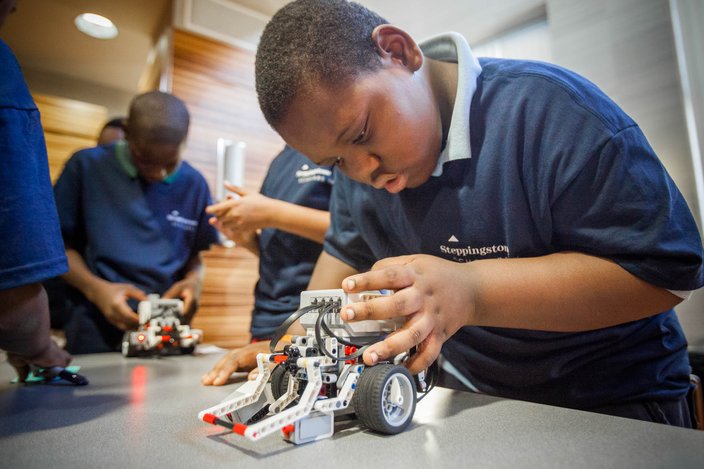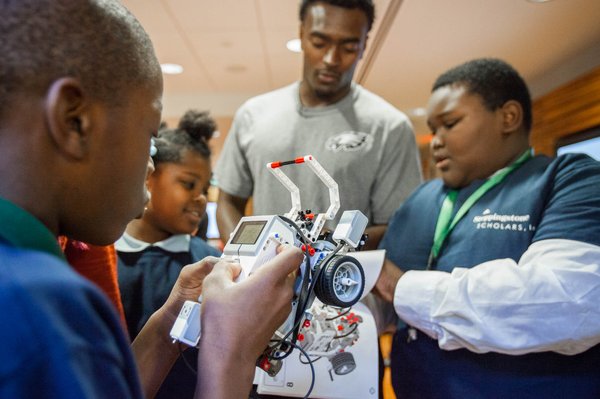A few Philadelphia Eagles learned some new moves on Monday when students from Philadelphia schools shared some lessons on robotics with the athletes.
At Temple University, rookie cornerback JaCorey Shepherd and wide receiver Jonathan Krause joined students from North Philly's Duckery Tanner and Paul Lawrence Dunbar elementary schools to learn about a robotics program that the students have begun this year.
The program, which has been brought to the schools by Steppingstone Scholars, a nonprofit group that brings academic programs to public schools in Philadelphia, teaches students how to build and program robots out of Lego blocks. For Monday's event, the students displayed robots that could be programmed to roll in a direction, pick up boxes and move them to set location.
According to Cashonna Thomas, a teacher and director of the robotics program at Dunbar, the kids were asked to think about problems in their own communities and then to look at robotics and find ways the robots could help address these issues.
The students, she said, picked "abandoned properties" as the biggest problem in their committees and then thought about how to fix the problem. Robots that could move trash and help clean abandoned lots, she said, became the students' focus.

Keith Gillespie, 10, a 4th grader at Duckery Elementary School programs a robot to move forward, Monday, December 14, 2015. (Thom Carroll / PhillyVoice)
"We wanted to find ways to use that land for something good," said Devon Davis, 11, a sixth-grader at Dunbar.
But learning how to make the robots do what they wanted took time, said Thomas.
"We had to do a lot of practice," she said.
The robots, she said, needed to be built and then programmed, step by step, in order to get the desired response. Making sure each step was programmed correctly, she said, was the only way to get the robots to work the way they wanted.
Figuring out how to program the robots correctly took a lot of trial-and-error, but the students seemed to enjoy the process, Thomas said.
"I like it, it's fun, but it's not just all about fun. It's about teamwork," said Natasha McGill, 11, a fifth-grader at Dunbar.
"Teamwork makes the dream work," agreed Dunbar fifth-grader, Saniya Brown, 10.
The students are preparing for an upcoming Lego League Challenge in January where their robotic creations will be tested against robots designed and built by students from other schools.
On Monday, the Eagles players were able to see how the students programmed the robots and watch them in action as they hauled small containers to and fro.
Sean Vereen, president of Steppingstone Scholars, said that the robotics program not only helps students learn about teamwork and mathematics, it also helps them understand real-world applications for the skills they gain while having fun building Lego creations with their friends.
"Whatever they end up doing [as adults], they have to have a knowledge about this," said Vereen. "It's an exciting way to learn about mathematics."
During the morning, Evan Hudson, 12, a sixth-grader at Duckrey school, spent much of the event teaching Shepherd how to program the robots. After showing the Eagles player what the robots can do, Hudson said he also talked about how he learned a lot about helping others as a team, just like the Eagles do on the field.
"We all worked as a group. It took a long time and it was frustrating, but, in the end, it turned out pretty cool," he said, smiling.
And, after taking in the event and posing for a few rounds of photos with the excited students, both Eagles players said they enjoyed the time and were glad to spend their Monday with some of the kids in the community.
"This is really a great program and we figured, why not come out today and support the kids?" said Krause.
In joking around about how complex the programming seemed for the small robots that the students made, Shepherd said he wished that he had a similar program when he was growing up, because it seemed complex, even for him as a 22-year-old college graduate.
"Man, this is truly amazing," he said. "I didn't have something like this when I was a kid."

